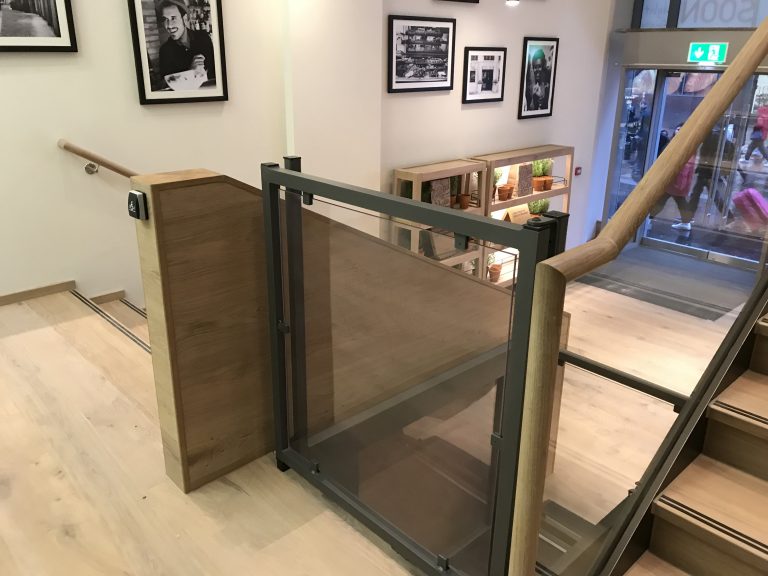How do platform lifts work?
Contents |
[edit] Introduction
Platform lifts allow a platform to rise up and down and are typically used for disabled access. They can be installed indoors or outdoors and offer access where passenger lifts cannot be installed. A platform lift can take a number of different forms, but primarily they are used in low-rise buildings due to potential building restrictions. They are cost-effective, easy to install.
[edit] Types of platform lifts
[edit] Step lift (vertical platform lift)
These lifts can be installed on the side of a step or steps to help the user to access another level whilst leaving the steps clear for other users. They provide travel up to one metre and can be used internally or externally.
[edit] Incline stair lift
These lifts enable wheelchair users to access the next storey using a stairlift with a level platform. The platform is fixed to a diagonal runner at the wall side of the staircase. They can be installed virtually anywhere, indoors and outdoors, and can be placed in straight or curved staircases with several landings or turns.
[edit] Vertical platform lift
Vertical platform lifts are similar to traditional enclosed lifts; however, they do not have the same capacity, speed or travel height as commercial lifts, making them better suited to domestic dwellings or smaller commercial buildings. The lift is self-supporting and requires limited building alterations compared with traditional lifts. It is secured to a wall and can be versatile in terms of design.
[edit] How do they work?
There are three main types of platform lift drive systems, each suited to different specifications, and each with their own advantages and disadvantages. Modern platform lifts are operated using electronic controls which send signals to a central processor unit. This unit initiates the motors or pumps to move the platform between levels.
[edit] Hydraulic drive system
For this system, the lift platform is attached to a hydraulic ram. To move the lift, hydraulic fluid is pushed via a pump from a central reservoir into the ram. The pressure extends the ram and causes the lift to rise; the flow is then reversed to lower the lift.
The main disadvantage to this system is that the mechanism requires extra space, and sometimes the hydraulic fluid can give off an odour in hot weather.
[edit] Screw and nut drive system
This lift utilises a steep screw pole which runs the length of the shaft. A motor on the platform drives a nut attached to the screw. When the motor turns the nut, the lift will go either up or down, depending on the direction it is turning. Installing this system often requires a supporting wall, especially on longer travel lifts, to stabilise the unit.
The disadvantage to this system is that the thread on the screw and drive nut is susceptible to wear and tear, requiring routine lubrication, often by a self-lubricating system.
[edit] Encapsulated chain drive system
The final system is the encapsulated chain drive system. This system makes use of a chain which is encased in a highly-durable polyurethane plastic casing which guides the chain and ensures it does not slip. A motor and gearbox turn a driveshaft which the chain is attached to. As the driveshaft rotates, the chains are either pulled or pushed, moving the platform up or down.
The advantage of this system is that its durability allows a much longer guarantee on the drive system.
--Nathan Massey 09:25, 20 Jul 2018 (BST)
[edit] Related articles on Designing Buildings Wiki
Featured articles and news
RTPI leader to become new CIOB Chief Executive Officer
Dr Victoria Hills MRTPI, FICE to take over after Caroline Gumble’s departure.
Social and affordable housing, a long term plan for delivery
The “Delivering a Decade of Renewal for Social and Affordable Housing” strategy sets out future path.
A change to adoptive architecture
Effects of global weather warming on architectural detailing, material choice and human interaction.
The proposed publicly owned and backed subsidiary of Homes England, to facilitate new homes.
How big is the problem and what can we do to mitigate the effects?
Overheating guidance and tools for building designers
A number of cool guides to help with the heat.
The UK's Modern Industrial Strategy: A 10 year plan
Previous consultation criticism, current key elements and general support with some persisting reservations.
Building Safety Regulator reforms
New roles, new staff and a new fast track service pave the way for a single construction regulator.
Architectural Technologist CPDs and Communications
CIAT CPD… and how you can do it!
Cooling centres and cool spaces
Managing extreme heat in cities by directing the public to places for heat stress relief and water sources.
Winter gardens: A brief history and warm variations
Extending the season with glass in different forms and terms.
Restoring Great Yarmouth's Winter Gardens
Transforming one of the least sustainable constructions imaginable.
Construction Skills Mission Board launch sector drive
Newly formed government and industry collaboration set strategy for recruiting an additional 100,000 construction workers a year.
New Architects Code comes into effect in September 2025
ARB Architects Code of Conduct and Practice available with ongoing consultation regarding guidance.
Welsh Skills Body (Medr) launches ambitious plan
The new skills body brings together funding and regulation of tertiary education and research for the devolved nation.
Paul Gandy FCIOB announced as next CIOB President
Former Tilbury Douglas CEO takes helm.
UK Infrastructure: A 10 Year Strategy. In brief with reactions
With the National Infrastructure and Service Transformation Authority (NISTA).
























